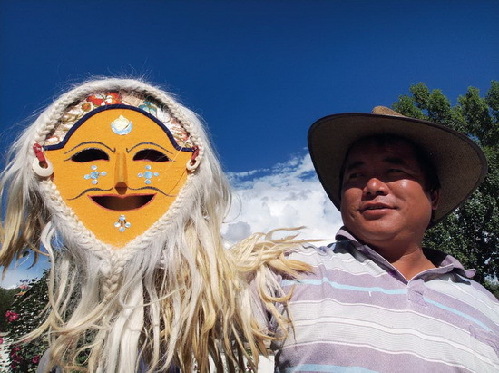
On August 14, 2012, a group of Tibetan farmers gathered in a cornfield by a hamlet in Changzhu Town, Nedong County, Shannan Prefecture in southern Tibet. They weren’t here, however, to farm or enjoy the country air, but to rehearse a unique form of Tibetan opera in preparation for the upcoming Lhasa Shoton Festival, one of the biggest events of the year among Tibetan communities. After a traditional drumtuning ritual involving the heating and cleaning of the leather-covered instrument, the rehearsal commenced to the sound of rumbling drums.
The play they, members of the Yarlung Tashi Serpa Opera Troupe, were rehearsing was Northanger His Holiness, a Yellow Mask Tibetan Opera classic that usually takes between five and seven hours to perform. Center stage, or field, was director and lead actor Nyima Tsering.
The 40-year-old is the officially appointed custodian of Yarlung Tashi Serpa Opera, a national intangible cultural heritage, and is colloquially referred to as the Yellow Mask Opera.
A Lasting Legacy of a Legendary Lama
Yarlung Tashi Sherpa is the original name of the town where the art was born and the troupe is based. Tibetan Opera is believed to be created by 14th-century lama Thangtong Gyalpo, who was also a talented architect, metallurgist and artist. During his alleged 125-year life he constructed 58 iron-chain bridges, much improving the road system in this mountainous region. As such, he is highly esteemed by Tibetans.
Yarlung Tashi Serpa is a genre of Tibetan Opera, distinguished from others in such aspects as rhyme scheme, dance steps, costumes and props. It still retains many unique details closely related to its founder Thangtong Gyalpo. For example, every performance starts with the yell of “yi hahahahahah,” an imitation of the unrestrained howls of excitement that escaped Thangtong when he received more donations of iron chains to make bridges.
Players of Yarlung Tashi Sherpa Opera wear yellow masks with white rims. This design is meant to commemorate Thangtong’s hard work forging iron for the bridges. Working by the hot charcoal furnace every day, his chest was blackened and his face became sallow.
It usually takes about two years to make one of these yellow masks, says Nyima Tsering, with the most timeconsuming task the creation of the goat hair that adorns it. Not every goat is suitable to produce fibers of the required standard. The craftsman must select a kid according to rigorous standards and then entrusts it to a local herdsman to raise it.
To guarantee a healthy body of hair, the animal is fed with the best fodder and groomed every day using a specialized method. When the goat reaches two years old it is slaughtered and skinned. The hide is tanned, trimmed and combed before being finally fastened to the mask.
According to Sonam Gyatso, a scholar of Tibetan folk literature, masks used in Tibetan Opera have been in many colors during its long history, including red, blue, black, white and yellow. In the past, says Gyatso, each color represented the different status and occupation of characters that wore them. For example, the yellow mask signified great virtues and extensive learning, and was hence reserved for dignitaries, while the blue mask was for young female roles. The yellow mask in Tashi Sherpa Tibetan Opera, therefore, conveys reverence and admiration for the opera’s founder, the respected and eminent guru.
